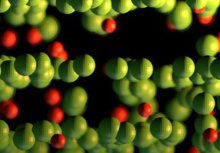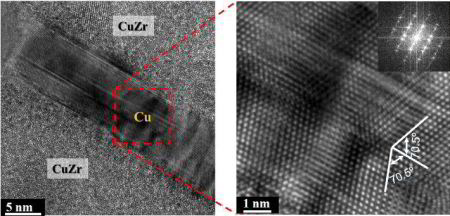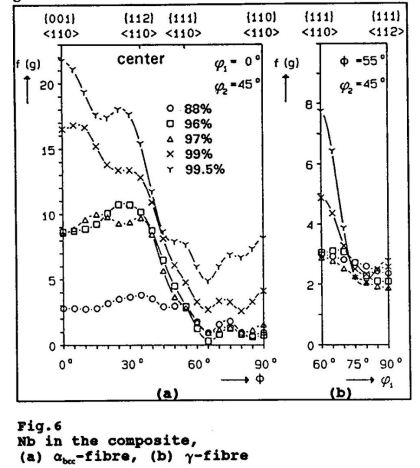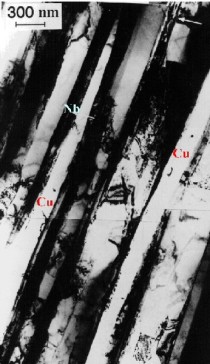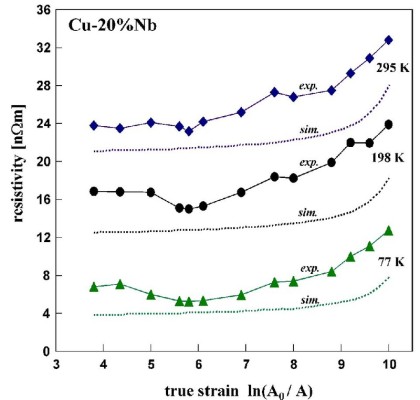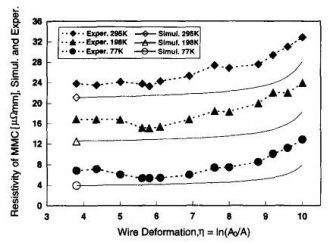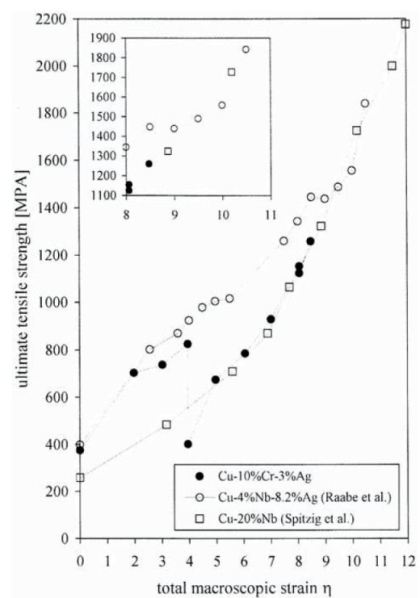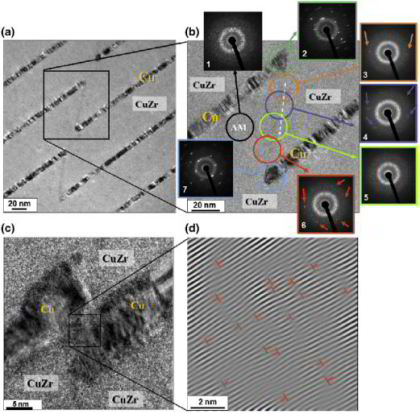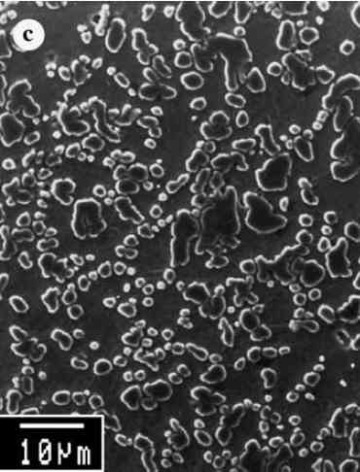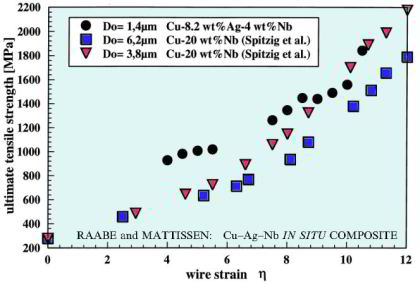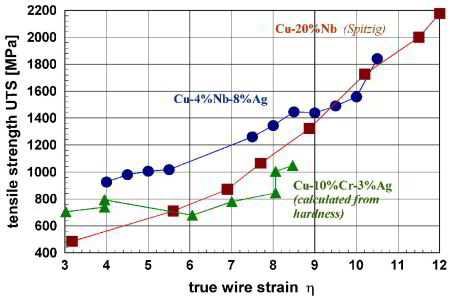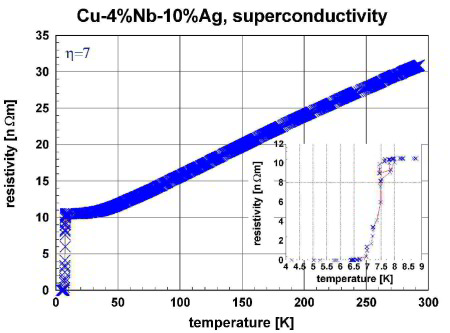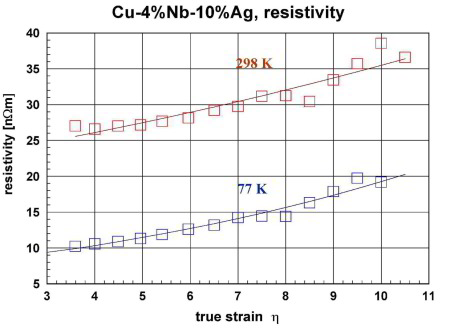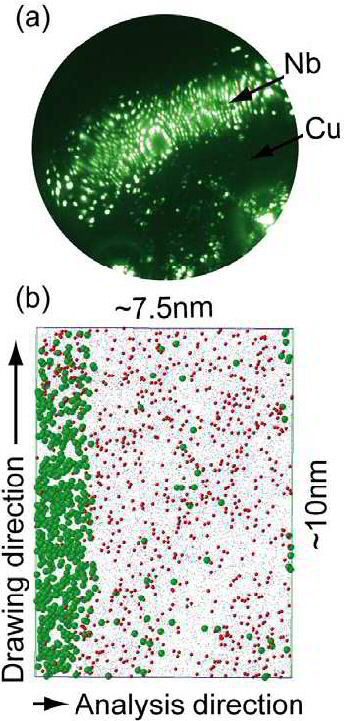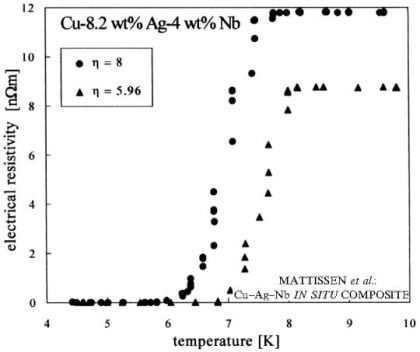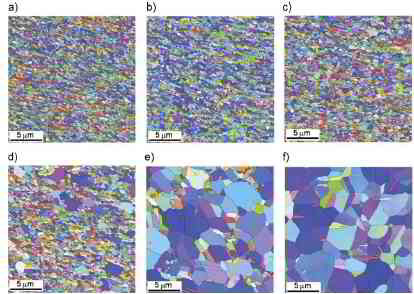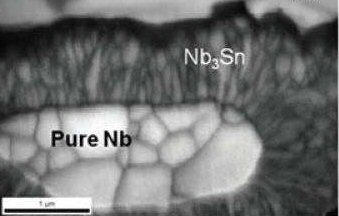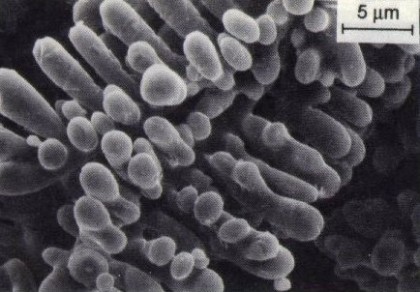Copper nano composites: Cu-Nb Metal matrix composites (MMC), Cu-Ag MMCs and ternary Cu-based MMCs
Why study Cu-based metal matrix nano-composites ?
Cu and Bcc elements such as Nb, Cr, Ta, Mo, V, Fe etc have negligible mutual solubility in the solid state.
Fibre reinforced in situ processed metal matrix composites (MMCs) Can hence be manufactured by large strain wire drawing or
massive cold rolling of a cast ingot. Such fcc - bcc Cu-Nb composites have been under intensive investigation for the past years mainly for the following reasons:
1) Firstly, the strength on the deformed MMC is much greater than expected fror the linear rufe of mixtures (ROM). Several models have been proposed to explain the observed strength anomaly.
2) Secondly, owing to the combination of high strength and good electrical conductivity Cu-Nb alloys are considered as candidate MMCs vor
producing highly mechanically stressed electrical devices, e.g. lang-pulse high-field resistive magnets and mechanically high stressed power cables.
How to produce Cu-based metal matrix composites?
Fibre or ribbon reinforced in situ metal matrix composites (MMCs) consisting of Cu and 20 wt% Nb can be produced by large strain wire drawing or massive cold rolling of as-cast samples with dendritic microstructures.
In our recent projects the microstructure of the composites was investigated by means of optical and electron microscopy.
The normal and superconducting properties of the MMC wires in the presence of external magnetic fields were examined and compared to the electromagnetic properties of pure Cu wires. The findings are discussed on the basis of the microstructural changes during deformation. The current results substantiate that the amount of internal boundaries and the filament spacing have considerable influence on the normal and superconducting properties of Cu-20% Nb.
Acta Materialia 80 (2014) 94-106
Intrinsic and extrinsic size effects in the deformation of amorphous CuZr/nanocrystalline Cu nanolaminates
Wei Guo, Eric Jägle, Jiahao Yao, Verena Maier, Sandra Korte-Kerzel, Jochen M. Schneider, Dierk Raabe
Acta Materialia 80 (2014) 94 Nanolaminat[...]
PDF-Dokument [3.9 MB]
The plastic deformation of metallic glasses profoundly differs from that of crystalline materials due to the absence of long-range atomic periodicity. While plasticity of crystals is
mainly achieved by dislocations, metallic glass is deformed through shear transformation zones [1] and shear bands [2]. Shear bands nucleate and propagate unpredictably upon yielding,
accompanied by strain softening and catastrophic failure [3]. This impedes the widespread use
of metallic glasses as structural materials, even though they possess some superior physical [4], chemical [5,6] and mechanical properties such as high strength [7,8] and high hardness
[9] when compared to crystalline matter. An important approach to increasing the ductility of a metallic glass is to introduce a softer crystalline phase into it [1]. This approach
works for Zr-based [10] and Cu-based [11] bulk metallic glasses. The soft crystalline phase is assumed to act as an absorber for deformation localization. It arrests the shear band and
disperses the stress, either by dislocation slip or phase transformation. However, a systematic study of the effects of size, shape and volume fraction of the soft crystalline phase on
the shear band controlled deformation has not been conducted due tothe difficulty of synthesizing well-defined amorphous/crystalline
composites.
Another way to enhance the plastic deformation of metallic glasses, besides inserting crystalline portions, is shape confinement: A decrease in the aspect ratio of the sample (i.e.
samples with small dimensions in the directions
perpendicular to the applied load) generates interacting, deflected shear bands with a wavy shape [12]. Previous works revealed the role of shape confinement in plasticity enhancement
[13] or even fracture prevention [12,14]. It was also found that reducing the sample size changes the deformation mode of metallic glasses at the submicrometer scale [15].
Instantaneous propagation of shear
bands can be effectively suppressed, resulting in a transition from highly localized shear banding to more homogeneous deformation under uniaxial compression. For example, a Zr-based
metallic glass has been reported to be “strong yet ductile” when probed at pillar size diameters of 100 nm [16]. Such apparent strength increase of metallic glasses by size reduction
can also originate from experimental factors. Therefore, these phenomena require more
clarification. Some pure nanocrystalline (nc) materials probed in submicron
scale mechanical experiments indeed exhibit a different trend. For example, Jang and Greer [17] studied Ni pillars with a grain size of 60 nm and micro-pillar diameters between 600 and
2500 nm. They found that pillars followed a “smaller is weaker” trend, caused by the increasing surface-dominated dislocation motion. They attributed this to a transition from
dislocation-driven deformation in larger pillars to grain-boundary-mediated deformation in smaller pillars. In view of these two different observations, the question arises whether the
deformation behavior is dominated by the nc phase or by the glassy phase in the case of a composite containing both glassy and nc portions at the sub-micron scale.
These two ideas, namely promoting ductilization by amorphous–crystalline composite design and by size control, motivated us to synthesize a multilayered glass-containing composite with
confined metallic glass fractions. The aim is to investigate the mechanical response and the governing deformation mode of such materials at the sub-micron scale.
Recently, investigations on such amorphous/nanocrystalline (am/nc) CuZr/Cu multilayers (also referred to as nanolaminates) have attracted considerable interest [18–22]. These earlier
works showed that the phase fractions can be tuned by controlling the layer thickness. For example, Kim et al. [20] studied 112 nm CuZr/16 nm nc Cu multilayers and found an enhanced
maximum strength
by adding nc Cu layers. Liu et al. [19] found that 500 nm CuZr/500 nm Cu nanolaminates exhibit a strong barreling effect (preferential deformation) of the nc Cu layers, whereas 100 nm
CuZr/100 nm Cu nanolaminates showed
higher strain compatibility. Zhang et al. [18] deformed CuZr/Cu (am/nc) nanolaminate pillars with equal layer thickness from 5 to 50 nm and observed a transition from pronounced
shear-banding to homogeneous deformation with increasing layer thickness. The above studies revealed that a multilayer structure consisting of an amorphous and a crystalline phase may
suppress percolative and hence catastrophic shear bands and enable plastic co-deformation of
the abutting phases if the layer thickness is carefully tuned. While it is clear that changing the layer thickness allows optimizing the mechanical response, the underlying reason for
the optimal thickness of the layers has yet to be identified.
Additionally, in crystalline/crystalline nanolaminates it was found that the yield stress increases when the layer thickness decreased due to “confined layered slip” [23]. In the am/nc
case, however, modifying the Cu layer thickness
changes not only the stress in the Cu layer but also the stress state in the glassy phase fraction. The influence of the nc Cu layer thickness on the shear band morphology at small
length scales is not yet clarified and will be also addressed in this work.
Therefore, in this work, amorphous CuZr/nc Cu nanolaminates with varying Cu layer thickness were synthesized. We first used nanoindentation testing to study the mechanical response
of these multilayers. Also, we fabricated micron- and submicron-scale pillars to study the effect of the crystalline (Cu) layer thickness on the deformation behavior of these
nanolaminates. Based on the experimental
observations, we study the deformation behavior as a function of the intrinsic Cu layer thickness and also of the extrinsic pillar size effect.
Scripta METALLURGICA et MATERIALIA
Vo1. 27, pp. 211- 216, 1992
D.Raabe, J.BalI,G.Gottstein
Scripta METALLURGICA vol 27 (1992) page [...]
PDF-Dokument [861.7 KB]
Copper and Niobium have no mutual solubility by practical standards. Therefore, fibre or ribbon reinforced in-situ MMCs can be produced by large degrees of deformation, e.g. by wire drawing
or rolling of a cast ingot. The Cu-20 vol% Nb composite has been under intensive investigation in the past owing to the high
tensile strength of the deformed material, actually much higher than expected from the rule of mixtures of the component strength [1-5]. Several models have been proposed to explain the observed
strength anomaly. The barrier model by Spitzig and coworkers [1-3,6,7] attributes the strength to tbe difficulty of propagating plastic through the fcc-bee interfaces while the group of
Courtney and coworkers interprets the strength in terms of geometrically necessary dislocations owing to the incompatibility of plastic deformation of the bcc and fcc phase [5]. In fact
both models are able to describe the observed increase of strength by assumption of reasonable fitting parameters. However, the actual structure evefutloa and strengthening processes are
still unknown.
This investigation is concerned with the texture development by rolling of Cu 20% Nb. The crystallographic texture is of interest for three reasons in this context. Firstly, the texture can be
very sensitive to the deformation process and microstructure evolution [12]. Secondly, the orientation distribution affects the
strength of the material in tenus of the Taylor factor [9-11]. Thirdly, the influence of a massive second phase on texture development is of general interest for texture evolution of in-situ
mechanically processed composites.
Binary and ternary metal matrix nano-composites (MMCs) with Cu as matrix and a body-centered cubic (bcc) transition metal (e.g. Nb, Fe, and Cr) and/or face-centered cubic (fcc) Ag as additional phase(s) have attracted much attention because of their extremely high work hardening combined with excellentelectrical conductivity.
Basic research interest in these alloys is mainly driven by the aim of understanding co-deformation among the phases and by ultra-high-strength electric wireapplications.
Cu and most bcc metals have small mutual thermodynamic solubility, leading totwo-phase microstructures. Upon straining, the phases form thin elongated filaments, rendering these alloys in situ MMCs.
The ther MMC refers to METAL-MATRIX-COMPOSITE. The high interface density obtained after large reductions leads to enormous Hall–Petch-type hardeningas was first reported for pearlitic wires and later for Cu-based composites.
For instance, wire-drawn MMC nano-composites consisting of Cu and 15 at.% Nb reveal an ultimate tensile strength (UTS) of up to 2.2 GPa (log. strain = 12).
Cu and Ag form a eutectic system with limited solubility. Alloys with more than 6 at.% Ag form a Cu-rich primary phase and a Cu–Ag eutectic. During deformation the eutectic
and the Cu-rich matrix form into filaments with similar microstructure and properties as Cu-bcc MMCs. Intermediate annealing leads to Ag precipitates;
these can increase the matrix strain and/or form additional fibers during deformation. After large strains, Cu–Ag MMCs reveal an UTS of up to 1.5 GPa (log. strain = 10). As
in the case of Cu-bcc alloys, the increase in strength
of Cu–Ag follows a Hall–Petch law.
The strength and electrical conductivity of near-eutectic Cu–Ag alloys show a dependence on strain similar to that of Cu-bcc alloys. Due to the high conductivity of the
constituents and the comparatively small contribution of inelastic electron scattering at interfaces, eutectic Cu–Ag MMCs reveal, at a given strength level, a somewhat better electrical conductivity
than Cu-bcc alloys. Based on these binary systems, ternary Cu-bcc-Ag composites were developed to combine the hardening of all three phases and the interfaces between them and at the same time reduce
the melting point. My current interest in these exiting Cu-based ultrastrong and electrically conducting
nanocomposites is fourfold:
1) First, Cu-based nanocomposites are promising materials for magnet design and robotics owing to their excellent combination
of strength and conductivity.
2) Second, Cu-based nanocomposites are interesting model composites for studying fundamental relations between strained lamellar microstructures on the one hand, and
mechanical and electrical properties on the other.
3) Third, heavily deformed Cu-based nanocomposites can undergo strain-induced chemical mixing (mechanical alloying) far beyond equilibrium
thermodynamics.
4) Fourth, Cu-based nanocomposites can even experience deformation-driven amorphization at the hetero-phase interfaces
Volume 43, Issue 4, April 1995, Pages 1467-1476
On the correlation of microstructure and electromagnetic properties of heavily cold worked Cu-20 wt% Nb wires
F. Heringhaus, D. Raabe, G. Gottstein
Acta metall mater. Vol. 43 (1995) 1467-1[...]
PDF-Dokument [906.5 KB]
Overview copper-composites-Z Mkde part 0[...]
PDF-Dokument [2.6 MB]
Overview copper-composites-Z Mkde part 0[...]
PDF-Dokument [2.6 MB]
References - Cu - nanocomposites
D. Raabe, F. Heringhaus: phys. stat. sol. (a) 142 (1994) 473-481
Correlation of superconductivity and microstructure in an in-situ formed Cu-20%Nb composite
F. Heringhaus, D. Raabe, G. Gottstein: Acta Metall. 43 (1995) 1467-1476
On the correlation of microstructure and electromagnetic properties of heavily cold worked Cu-20 wt.% Nb wires
U. Hangen, D. Raabe: Acta Metall 43 (1995) 4075-4082
Modelling of the yield strength of a heavily wire drawn Cu-20%Nb composite by use of a modified linear rule of mixtures
U. Hangen, D. Raabe: phys. stat. sol. (a) 147 (1995) 515-527
Experimental investigation and simulation of the normal conducting properties of a heavily cold rolled Cu-20mass% Nb in situ composite
D. Raabe, U. Hangen: Journal of Materials Research 12 (1995) 3050-3061
Investigation of structurally less ordered areas in the Nb filaments of a heavily cold rolled Cu-20wt.% Nb in-situ composite
D. Raabe, U. Hangen: Acta metall. 44 (1996) 953-961
Correlation of microstructure and type II superconductivity of a heavily cold rolled Cu-20mass% Nb in situ composite
D. Raabe, U. Hangen: Materials Letters 22 (1995) 155-161
Observation of amorphous areas in a heavily cold rolled Cu-20wt.% Nb composite
D. Raabe, F. Heringhaus, U. Hangen, G. Gottstein: Z. Metallk. 86 (1995) 405-422
Investigation of a Cu-20mass%Nb in situ Composite
Part I: Fabrication, Microstructure and Mechanical Properties
Part II: Electromagnetic Properties and Application
F. Heringhaus, D. Raabe: J. Mater. Proc. Techn. 59 (1996) 367-372
Recent advances in the manufacturing of copper-base composites
D. Mattissen, D. Raabe, F. Heringhaus: Acta Mater. 47 (1999) 1627-1634
Experimental investigation and modeling of the influence of microstructure on the resistive conductivity of a Cu–Ag–Nb in situ composite
D. Raabe, D. Mattissen: Acta Mater. 46 (1998) 5973-5984
Microstructure and mechanical properties of a cast and wire drawn ternary Cu-Ag-Nb in situ composite
D. Raabe, D. Mattissen: Acta Mater. 47 (1999) 769-777
Experimental investigation and Ginzburg–Landau modeling of the microstructure dependence of superconductivity in Cu-Ag-Nb wires
D. Mattissen, D. Raabe, F. Heringhaus: Acta Mater. 47 (1999) 1627-1634
Experimental investigation and modeling of the influence of microstructure on the resistive conductivity of a Cu–Ag–Nb in situ composite
S. Ohsaki, D. Raabe, K. Hono: Acta Materialia 57 (2009) 5254-5263
Mechanical alloying and amorphization in Cu-Nb-Ag in situ composite wires studied by transmission electron microscopy and tomographic atom probe
D. Raabe, P. P. Choi, Y.J. Li, A. Kostka, X. Sauvage, F. Lecouturier, K. Hono, R. Kirchheim, R. Pippan, D. Embury: MRS Bulletin 35 (2010) 982-991
Metallic composites processed via extreme deformation: Toward the limits of strength in bulk materials
Materials Science and Engineering A291 (2000) 186-197; Processing, microstructure, and properties of ternary high-strength Cu–Cr–Ag in situ composites by D. Raabe, K. Miyake, H. Takahara
Materials Science and Engineering A291 ([...]
PDF-Dokument [791.8 KB]
A new class of ternary in situ metal matrix composites (MMCs) with high strength and high electrical conductivity consisting of heavily co-deformed Cu, Cr, and Ag is introduced. Three alloys
are investigated in detail, namely, Cu–10wt.%Cr–3wt.%Ag, Cu–10wt.%Cr–1wt.%Ag, and Cu–4.5wt.%Cr–3wt.%Ag. The alloys were produced by inductive melting and chill casting. Because Cu–Cr and
Cu–Cr–Ag alloys with hypereutectic Cr content are less ductile than previously investigated Cu–Nb, Cu–Ag, and Cu–Nb–Ag alloys, special attention was placed on optimizing microstructure with
respect to both strength and ductility using thermal and thermo-mechanical processing schemes. These included various combinations of swaging, heavy wire deformation (using different
lubricants), solution annealing at different temperatures followed by quenching, and aging at
different temperatures. Optimized processing allows one to attain maximum wire strains of 8.48 (ln(A0/A), A: wire cross-section). The wires have very high strength (for instance
Cu–10wt.%Cr–3wt.%Ag: 1260 MPa at a strain of =8.48) and good electrical conductivity (62% of the conductivity of pure Cu (IACS) at a strain of 2.5 after solution treatment). Up to
wire strains of 8.5 the strength is equal to that of Cu–20wt.%Nb. The wire strength is much higher than predicted by the linear rule of mixtures. The investigation presents the evolution of
microstructure during the various thermo-mechanical treatments and
relates the results to the observed mechanical and electrical properties. The strength is discussed in terms of Hall–Petch-type hardening.
Wei Guo,Eric A. Jägle, Pyuck-Pa Choi, Jiahao Yao, Aleksander Kostka, Jochen M. Schneider, Dierk Raabe
PRL 113, 035501 (2014)
PHYSICAL REVIEW LETTERS
18 JULY 2014
Guo Raabe PHYSICAL REVIEW LETTERS vol 11[...]
PDF-Dokument [2.1 MB]
Deformation of ductile crystalline-amorphous nanolaminates is not well understood due to the complex interplay of interface mechanics, shear banding, and deformation-driven chemical mixing. Here we present indentation experiments on 10 nm nanocrystalline Cu–100 nm amorphous CuZr model multilayers to study these mechanisms down to the atomic scale. By using correlative atom probe tomography and transmission electron microscopy we find that crystallographic slip bands in the Cu layers coincide with non-crystallographic shear bands in the amorphous CuZr layers. Dislocations from the crystalline layers drag Cu atoms across the interface into the CuZr layers. Also, crystalline Cu blocks are sheared into the CuZr layers. In these sheared and thus Cu enriched zones the initially amorphous CuZr layer is rendered into an amorphous plus crystalline nanocomposite.
Scripta Materialia 51 (2004) 915-920; by D. Raabe and J. Ge
Scripta Materialia 51 (2004) 915 Cu in s[...]
PDF-Dokument [444.4 KB]
We investigate Cr filaments in heavily drawn Cu–10 wt.%Cr–3 wt.%Ag in situ composite wires as a function of temperature and time. The filaments undergo a capillarity-driven shape change from a bamboo morphology with grain boundary grooves to complete spherodization. We interpret the results in terms of analytical models.
Owing to their excellent strength and good resistive conductivity Cu-based in situ composites play a key role for the manufacturing of high mechanically stressed
electrical devices. Prominent examples are in the areas of high field capacitor driven pulsed or steady state Bitter-type direct current magnet design, robotics, cables, and electrical contacts.
While in the past, much attention was placed on binary alloys consisting of Cu and a body centered cubic (bcc) metal or Cu and Ag, less efforts were made to widen the spectrum of in situ
metal–matrix composites towards ternary Cu-based alloys. Some recent investigations have aimed to fill that gap. Morris and Joyce worked on hypereutectic Cu–2 wt.% Cr–0.3 wt.% Zr alloys,
Verhoeven on Cu–15 wt.% Nb–2 wt.% Ag alloys, Troxel on dispersoid-strengthened Cu–10 wt.% Nb–(0.3...1.1) wt.% Al2O3 alloys, Fritzemeier on Cu–15 wt.% Nb–2 wt.% Ag alloys, Spitzig on Cu–20
wt.%
Nb–7 wt.% Ag alloys, Spaic and Pristavec on Cu–(1...7) wt.% Ag–0.3 wt.% Zr alloys, Raabe and Mattissen on Cu–4 wt.% Nb–8.2 wt.% Ag alloys, and Miyake on Cu–(4.5...10) wt.% Cr–(13...3) wt.%
Ag. The basic strategy in ternary alloy development lies in exploiting filamentary Hall–Petch-type as well as age
hardening at the same time. Both effects are due to the interaction of mostly incoherent heterophase interfaces with lattice dislocations. This means that the physics of hardening in ternary
alloys has the same origin as in binary alloys. However, adding a third chemical element allows for a larger variety of possible kinetical paths for attaining a well tailored flow
stress-conductivity profile.
During operation in magnets and power-carrying cabling, Cu-base composites undergo resistive heating. This effect may entail microstructural changes leading to a degradation of
the composite properties. Designing magnets for prolonged service, therefore, requires better knowledge about the microscopic thermal stability and the resulting macroscopic property
changes of the materials. The most significant effect observed in Cu- and Ag based metal–matrix composites upon heat treatment is the capillarity-driven shape change of the filaments.
The microstructural changes are characterized by the formation of a bamboo-type morphology followed by fiber break-up, spherodization, and coarsening. This topological evolution was described in
a number of studies. It was also observed in these studies that the described steps did not happen in strict consecutive order but occurred in part simultaneously. This means that
different stages of coarsening were found in different parts of the same sample due to the size distributions of the filaments and the overlap of the diffusion fields. A detailed
investigation and understanding of the described shape changes is of relevance for two reasons. First, the strength of such in situ composites is to a large extent governed by the spacing of the
heterophase interfaces
following a modified Hall–Petch-type relationship. Therefore, one may expect that filament breakup and coarsening leads to a drop in flow stress. Second, a more fundamental interest of this
study lies in elucidating the kinetics of the observed morphological changes.
Acta mater. Vol. 46, No. 16, pp. 5973-5984, 1998; by D. Raabe and D. Mattissen
Acta mater. Vol. 46 (1998) pp. 5973 Cu [...]
PDF-Dokument [543.4 KB]
A ternary in situ metal matrix composite consisting of Cu, 8.2 wt% Ag and 4 wt% Nb was produced by inductive melting, casting, and subsequent wire drawing. The material was very ductile so that
a maximum wire strain of Z= 10.5 was attained without intermediate annealing (Z =ln(A0/A), where A is the wire cross-section). The wire has a very high strength (1840 MPa at Z=10.5) and at
the same time good electrical conductivity (46% of the conductivity of pure Cu). The wire strength is much larger than predicted by the linear rule of mixtures. Up to wire strains of Z18
the strength even exceeds that of Cu-20 wt% Nb. The paper concentrates on the investigation of the evolution of the filament microstructure
during wire drawing and its relation to the observed mechanical properties. The strength is discussed in terms of a Hall±Petch- or phase-barrier-type eect that arises from lattice dislocation
pile-ups at the interfaces.
Acta metal!. mater. Vol. 43 pp. 4075-4082,1995
Acta Materilia Modeling yield strength C[...]
PDF-Dokument [479.0 KB]
Acta Materialia 57 (2009) 5254-5263
Acta Materialia 57 (2009) 5254 Copper Ni[...]
PDF-Dokument [1.1 MB]
We have studied deformation-driven alloying in a Cu–5 at.% Ag–3 at.% Nb in situ composite by transmission electron microscopy and atom probe tomography. In addition to alloying at interfaces,
amorphization of nanosized Cu areas was observed after heavy wire drawing (true strain: eta = 10.5) at some of the Cu–Nb interfaces. We discuss the alloying in terms of trans-phase
dislocation-shuffling and shear banding mechanisms where lattice dislocations penetrate the interfaces between abutting phases. We interpret local amorphization in terms of the
thermodynamic destabilization of a Cu–Nb crystalline phase between 35 and 80 at.% Cu due to enforced mixing. Defor-
mation-driven mechanical alloying and amorphization are hence closely associated phenomena.
Acta mater. Vol. 47, No. 5, pp. 1627-1634, 1999
by
D. MATTISSEN, D. RAABE and F. HERINGHAUS
Acta mater. Vol. 47 pp. 1627 (1999) cond[...]
PDF-Dokument [378.0 KB]
A Cu-8.2 wt% Ag-4 wt% Nb in situ metal matrix composite was manufactured by inductive melting, casting, swaging, and wire drawing. The final wire ( ln
A0=A 10:5, A: wire cross
section) had a strength of 1840 MPa and 46% of the conductivity of pure Cu. The electrical resistivity of the composite wires was experimentally investigated as a function of wire strain and
temperature. The microstructure was examined by means of optical and electron microscopy. The observed decrease in conductivity with increasing wire strain is interpreted in terms of inelastic
electron scattering at internal phase boundaries. The experimental data are in very good accord with the predictions of an analytical size-effect model which takes into account the development
of the filament spacing as a function of wire strain and the mean free path of the conduction electrons as a function of temperature. The experimentally obtained and
calculated resistivity data are compared to those of the pure constituents.
ADVANCED ENGINEERING MATERIALS 2011, 13, No. 4
ADVANCED ENGINEERING MATERIALS 2011, 13,[...]
PDF-Dokument [756.7 KB]
Ultrafine-grained (UFG) materials processed by severe plastic deformation are known to exhibit good mechanical properties. Much about the annealing behavior of such materials is still
unknown, and this work aims to provide a better understanding of the thermal properties of UFG materials. For this
purpose a Cu–0.17 wt%Zr alloy was subjected to high pressure torsion (HPT) with a maximal pressure of 4.8 GPa at room temperature. The microstructures of the specimens were characterized
using electron back scatter (EBSD) measurements, transmission electron microscopy (TEM), and hardness
measurements. During annealing of the samples, dispersoids were formed which improved the thermal stability of the alloy. At higher strain levels the fraction of high angle grain boundaries
(HAGBs) increased above 70% of the total grain boundaries.
Physics Procedia bronze route supercondu[...]
PDF-Dokument [420.6 KB]
High-resolution EBSD technique and DC magnetization were used to characterize a Cu-Nb reinforced bronze route Nb3Snsuperconducting multifilamentary wire.
Copper-Niobium composites: microstructures, electromagntic properties, mechanical properties
Overview copper-composites-Z Mkde part 0[...]
PDF-Dokument [2.6 MB]
PDF-Dokument [2.6 MB]
Acta Mater 2014 Texture shear bands Cu-A[...]
PDF-Dokument [4.7 MB]
